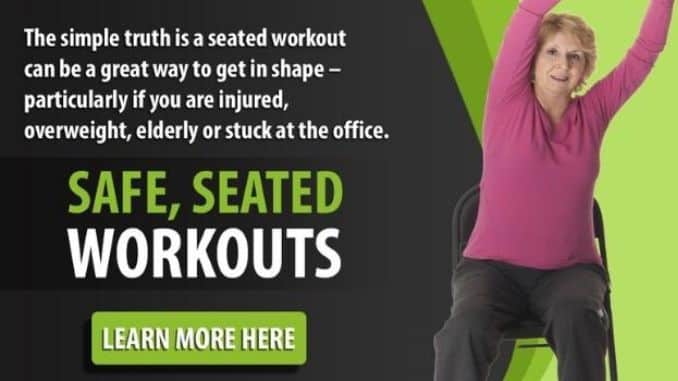Have you ever felt a sharp pain in your wrist or thumb, like gamers thumb, while lifting something? If so, you might be dealing with De Quervain’s tenosynovitis—a condition that affects the tendons at the base of your thumb. I’ve been there, and trust me, getting the right de Quervain treatment makes all the difference.
What is De Quervain’s Tenosynovitis?
De Quervain’s tenosynovitis [1], also known as gamer’s thumb, is an inflammatory condition that affects the two tendons; abductor pollicis longus (APL) and the extensor pollicis brevis (EPB), on the thumb side of your wrist (Bailey, 2023).
De Quervain’s tenosynovitis is a condition that causes pain and inflammation in the tendons at the base of the thumb. It’s also known as “caregiver’s wrist”, “Texter’s thumb”, and “gamer’s thumb”.
It is considered to be very painful and that pain is felt when you turn your wrist, grasp anything or make a fist.
A tendon sheath is a protective covering that allows you to turn your wrist, grip it, and pinch your hand.
It makes the tendons slide easily as you stretch, turn, and maneuver through the motion, helping to alleviate discomfort from conditions like gamers thumb.
The tendon sheath may be thin but composed of fibrous and synovial layers.
These are flexible layers that move as the tendons move, commonly associated with gamer’s thumb.
However, it can get inflamed, causing pain and discomfort, especially in cases of gamers thumb.
Those playing sports with rackets, lifting their baby, playing golf, or working in the garden that involves repetitive hand or wrist movement suffer from De Quevain’s tenosynovitis.
It is also evident in those using a hammer, carrying heavy groceries or bags, typing, and knitting.
Dr. Jayson Chen, a leading orthopedic specialist, notes that “without proper treatment, this condition can lead to chronic pain and limited thumb mobility.” This is why acting early is crucial.
Causes and Risk Factors
De Quervain’s tenosynovitis is a condition that primarily affects the tendons on the thumb side of your wrist. While the exact cause remains unclear, it’s widely believed to stem from repetitive strain, overuse, or injury to the tendons.
Activities that involve repetitive wrist or thumb movements, such as texting, typing, or lifting, can contribute to the development of this condition.
Additionally, inflammatory conditions like rheumatoid arthritis and gamers thumb can exacerbate the issue.
Interestingly, pregnancy and nursing are also linked to De Quervain’s tenosynovitis. The repetitive motion of lifting and carrying an infant can strain the tendons, leading to inflammation and pain.
Here are some key risk factors to be aware of:
- Repetitive Strain or Overuse: Frequent wrist and thumb movements can lead to tendon irritation.
- Injury or Trauma: Direct injury to the thumb or wrist can trigger the condition.
- Inflammatory Conditions: Diseases like rheumatoid arthritis can increase the risk.
- Pregnancy and Nursing: Hormonal changes and repetitive lifting of an infant can cause tendon strain.
- Certain Occupations or Activities: Jobs or hobbies that involve repetitive wrist or thumb movements, such as gardening, playing musical instruments, or assembly line work, can increase the risk.
De Quervain’s Tenosynovitis Signs and Symptoms
De Quervain’s tenosynovitis may cause different symptoms, such as:
- Pain at the side of your wrist under the base of your thumb
- Also, movement on your thumb exacerbates the pain.
- Pain on the wrist that has spread into your thumb and forearm.
- Mild wrist swelling, redness, or warmth
- Formation of a fluid-filled cyst near the side of your wrist.
- Pain along the back of your thumb, directly over the two tendons.
The condition, often referred to as “gamer’s thumb,” can ensue gradually or happen suddenly.
Regardless, the pain may start from your thumb or up your forearm.
It may be painful to move your thumb, especially when you try to pinch or grasp things.
The pain is worse when you move your thumb or wrist.
The hallmark symptom of De Quervain’s tenosynovitis is a sharp, aching pain at the base of the thumb.
This pain can extend up the forearm and may be accompanied by swelling and a catching or snapping sensation when moving the thumb.
Some people also experience numbness along the thumb and index finger, which can sometimes radiate into the forearm.
The pain may be constant or intermittent, often worsening with activities that involve gripping or pinching. Simple tasks like opening a jar, lifting a child, or even texting can become excruciating.
To diagnose De Quervain’s tenosynovitis, healthcare providers typically rely on a physical examination and a review of your medical history.
One common diagnostic test is the Finkelstein test. During this test, you bend your thumb into your palm and then cover it with your fingers.
If this movement causes pain along the thumb side of your wrist, it’s a strong indicator of De Quervain’s tenosynovitis.
How Is De Quervain’s Tenosynovitis Diagnosed?
Some may have X-rays done, but it is not necessarily needed to diagnose the condition [2].
Your doctor may perform a simple test to diagnose De Quervain’s tenosynovitis.
The test is called the Finkelstein Test. You might be asking…
What is The Finkelstein Test?
The Finkelstein Stretch is a simple test and therapeutic stretch used to assess and relieve symptoms of De Quervain’s Tenosynovitis (Challoumas et. al. 2023).
It is often used by healthcare professionals as a diagnostic test, it can also help alleviate symptoms when done gently as part of therapy.
When the test is done in a healthy wrist, this creates a mild stretch sensation, commonly used to assess for conditions like gamer’s thumb.
However, if De Quervain’s Tenosynovitis is present, it can cause sharp pain along the tendons, indicating irritation or inflammation.
If there is intense pain, the stretch should be done with caution, as aggressive stretching can worsen inflammation.

Here’s how you perform the test:
- Bend your thumb so it rests across your palm.
- Bend your wrist toward your little finger.
- Then you make a fist, closing your fingers over your thumb.
How to interpret the result:
- Negative result: No pain/ radiating pain is felt on the inside of your arm from the thumb.
- Positive result: If you felt tenderness or pain at the base of your thumb. It can be felt up the inside of your arm from the thumb.
Your condition’s symptoms [3] and physical condition will help see if you have de Quervain’s tenosynovitis.
They will also ask you to do certain movements with your hand, wrist, and thumb to evaluate for conditions like gamer’s thumb.
De Quervain’s Tenosynovitis Treatment
De Quervain’s tenosynovitis treatment is focused on the following:
- Pain and swelling reduction
- Maintain normal joint function
- Preventing the recurrence of the condition
Pain and swelling reduction treatment include:
- Ice or heat application to the affected area
When Using Heat: Fill a water bottle with warm water and place it on your wrist.
- You may also use a heating pad.
- Ensure the water bottle or heating pad isn’t too hot before putting it on your wrist.
- Apply it for 15 minutes every 4 to 6 hours.
- Don’t leave the water bottle or heating pad on for over 15 minutes.
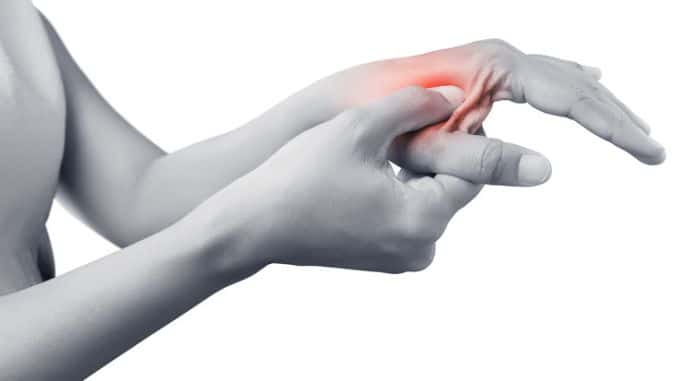
When Using Ice: Apply an ice pack for 10 to 15 minutes every 4 to 6 hours.
- Nonsteroidal anti-inflammatory drug (NSAID) medication such as ibuprofen (Advil, Motrin) or naproxen (Aleve).
- Refrain from repetitive hand and wrist motions or activities that may cause pain and swelling.
- Wearing a splint 24 hours a day for 4 to 6 weeks to rest your thumb and wrist.
- Getting steroid injections or a local anesthetic (numbing medicine) into the tendon sheath. These injections are effective in reducing pain and swelling.
For De Quervain’s case, exercise is important in maintaining normal joint function and preventing the recurrence of the condition.
While recovering from gamer’s thumb, it will help you to do your daily activities while wearing a splint.
Adjust your home and work activities to lessen the stress on your wrist and prevent gamer’s thumb.
Most people notice improvement in gamers’ thumb after 4 to 6 weeks of treatment.
Once you can use your hands and wrists without pain with the swelling is gone, you should start doing exercises.
Do exercises to strengthen your arm, wrist, and hand as part of De Quervain’s treatment while you recover.
Why Treatment Matters
Ignoring the symptoms of De Quervain’s can turn a mild annoyance into a long-term problem. I delayed treatment at first, thinking it would resolve on its own—big mistake.
By the time I sought help, basic tasks like texting or cooking had become unbearable due to gamer’s thumb.
Effective treatment options for de Quervain disease include splinting, corticosteroid injections, and physical therapy.
Effective treatment not only reduces pain but prevents further damage, giving you back your mobility and quality of life.
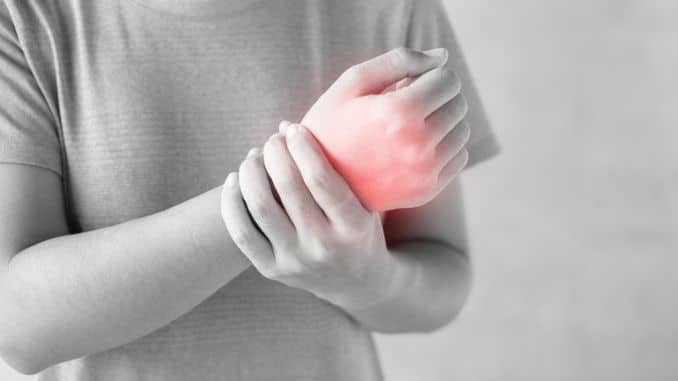
Non-Surgical Treatment Options
For many, non-surgical treatments [4] can provide significant relief.
Here’s what worked for me:
- Rest and Immobilization: A thumb splint was my saving grace. It kept my wrist in a neutral position, reducing strain.
- Medication: Over-the-counter anti-inflammatory meds like ibuprofen eased the pain quickly.
- Physical Therapy: Simple exercises, like thumb stretches, improved my mobility in just a few weeks.
Consulting with experienced orthopedic surgeons can provide specialized care and improve treatment outcomes.

Advanced Surgical Treatment Methods
If conservative treatments don’t work, other surgical interventions are available:
- Corticosteroid Injections: These injections are highly effective in reducing inflammation. My physical therapist referred to them as a “game-changer” for stubborn cases.
- Surgery: While it sounds daunting, surgery for De Quervain’s is minimally invasive. It involves releasing the tendon sheath to ease pressure, and recovery is faster than you’d think.
However, there is a risk of superficial radial nerve injury, which can lead to significant limitations in hand and wrist function.
Surgical Treatment for De Quervain’s Tenosynovitis
When non-surgical treatments fail to provide relief, surgical treatment becomes a viable option for De Quervain’s tenosynovitis.
The primary goal of De Quervain’s treatment surgery is to release the tendon sheath, which reduces pressure and allows the tendons to glide more smoothly.
During the surgical procedure, an orthopedic surgeon makes a small incision over the first dorsal compartment of the wrist.
The surgeon then carefully releases the tendon sheath, ensuring that the tendons of the extensor pollicis brevis and abductor pollicis longus can move freely. This surgical release alleviates the pain and restores function to the affected thumb and wrist.
Most patients experience significant pain relief and improved mobility following the surgery. The procedure is minimally invasive, and recovery is typically swift, with many patients returning to their normal activities within a few weeks.
However, as with any surgical intervention, there are potential risks, including infection and complications related to wound healing. Patients with diabetes may face a higher risk of these complications.
Surgical treatment for De Quervain’s tenosynovitis offers a high success rate, especially for those who have not found relief through conservative methods.
If you’re considering this option, consult with an orthopedic surgeon to discuss the potential benefits and risks based on your specific condition.
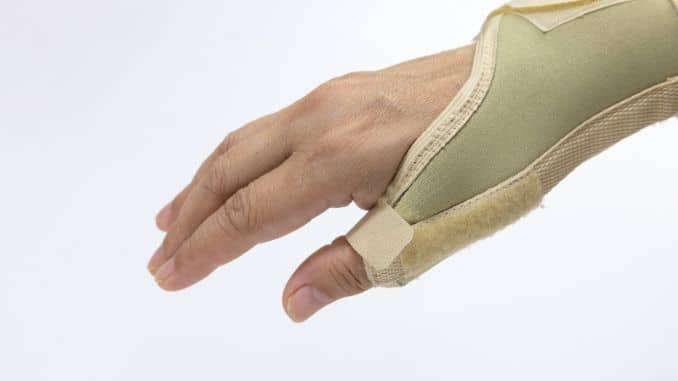
Self-Care and Prevention Tips
Prevention is better than cure, and I’ve made small changes to keep the pain at bay:
- Ergonomics: Adjusting my workspace to keep my wrist neutral was a game-changer.
- Regular Breaks: I set a timer to remind myself to stretch during repetitive tasks.
- Exercises: Daily thumb stretches have become part of my routine, ensuring my tendons stay flexible.
Home Exercises For De Quervain’s Tenosynovitis
De Quervain’s tenosynovitis strengthening exercises have been shown to speed up the healing process (Goel & Abzug, 2015).
It also helps in reducing your gamers thumb symptoms.
In doing De Quervain’s Tenosynovitis exercises, you’ll need these types of equipment:
- Putty Ball/Squeeze Ball
- Elastic Resistance Band
- Rubber Band
- Small Weight
Without a small weight, you can use a can of food, a hammer, or a water bottle filled with water, sand, or rocks.
These De Quervain’s tenosynovitis exercises can be done a few times throughout the day. In doing so, make sure to listen to your body.
It should not cause any additional stress on the healing tendon sheath.
Meanwhile, if this does happen, you may need to lessen the repetitions, or you can rest on alternate days.
When exercising, only stretch as far as the end of the range possible without pain.
However, don’t force yourself into assuming any position.
Also, refrain from jerky movements to avoid gamer’s thumb and support De Quervain’s treatment by making the movement slow and smooth.
De Quervain’s Tenosynovitis Exercises
1. Thumb Lifts
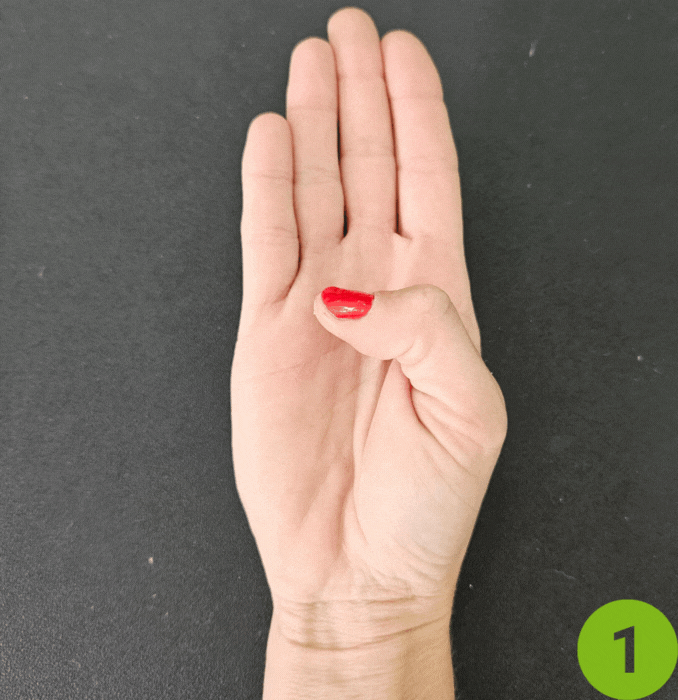
- In this De Quervain exercise, start with your hand on a flat surface with your palm facing up. Rest the tip of your thumb at the base of your fourth finger.
- Lift your thumb away from your palm so it’s nearly perpendicular to the forefinger side of your hand.
- You’ll feel a stretch at the back of your thumb and across your palm.
- Keep your thumb extended for about 6 seconds and release. Repeat 8 to 12 times.
- Then, place your hand on a table with your palm facing up. Lift your thumb and your pinky.
- Gently press the tips of your thumb and pinky together.
- You’ll feel a stretch at the base of your thumb.
- Hold this position for 6 seconds. Lastly, release and repeat 10 times.
2. Opposition Stretch
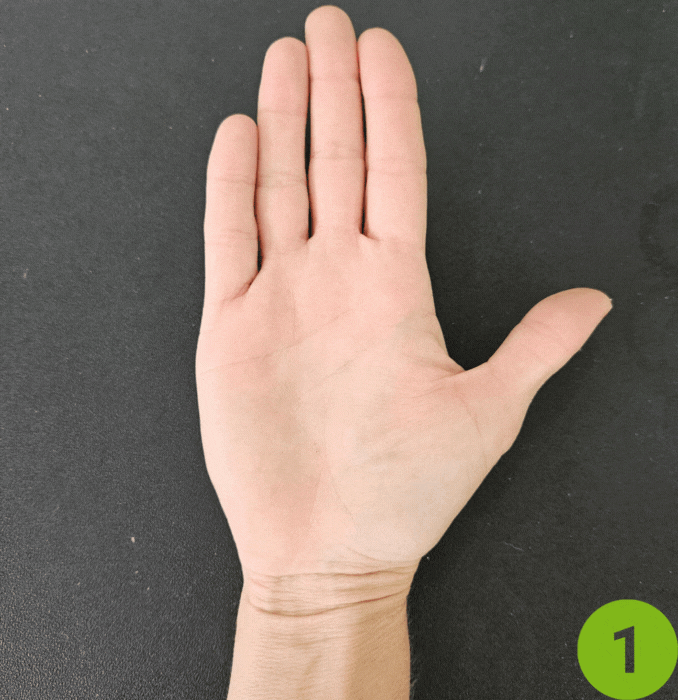
- Firstly, start by resting your hand on a table with your palm facing up.
- Touch the tip of your thumb to the tip of your little finger to prevent or ease gamers’ thumb.
- Hold this position for 6 seconds and then release. Repeat 10 times.
3. Thumb Flexion/Extension
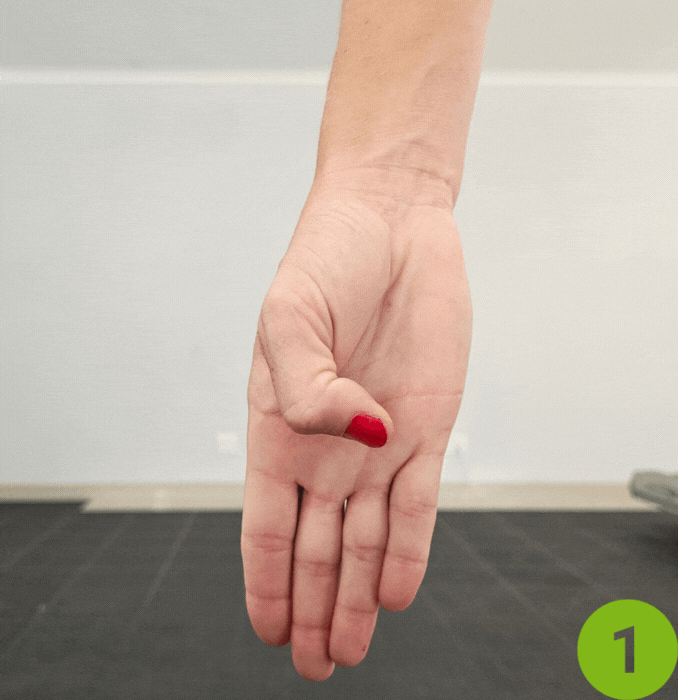
For this exercise, you can place your hands on the table or hang them at your side as you perform this movement.
- Firstly, Bend your thumb downward and across your palm so that your thumb touches the base of your little finger.
- Hold that position for about 6 seconds to relieve gamers’ thumb.
- Then, straighten your thumb. Repeat 8 to 12 times. Switch hands, and repeat steps 1 through 3.
4. Finkelstein Stretch
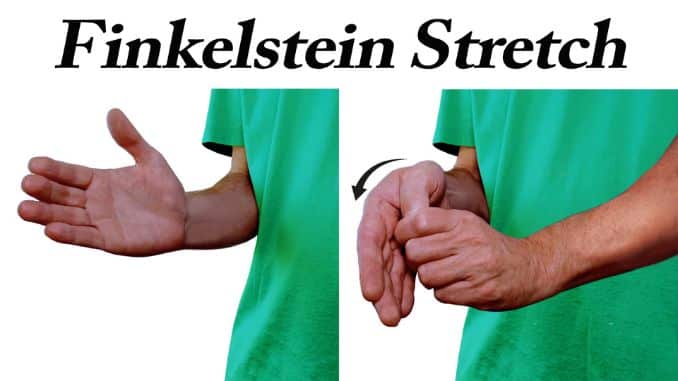
- Hold your arms out in front of you. (Your hand should be in the position used for shaking someone’s hand.)
- Then, bend your thumb toward your palm. Use your other hand to gently stretch your thumb and wrist downward until you feel the stretch on the thumb side of your wrist.
- Hold for at least 15 to 30 seconds. Repeat 2 to 4 times.
5. Wrist Flexion

- Hold a can or hammer handle with your palm facing up to help alleviate gamer’s thumb.
- Then, bend your wrist upward. Slowly lower the weight and return to the starting position.
- Do 2 sets of 15. Gradually increase the weight of the can or weight you are holding.
- And finally, as you get stronger, you can gradually increase your weight.
6. Wrist Extension
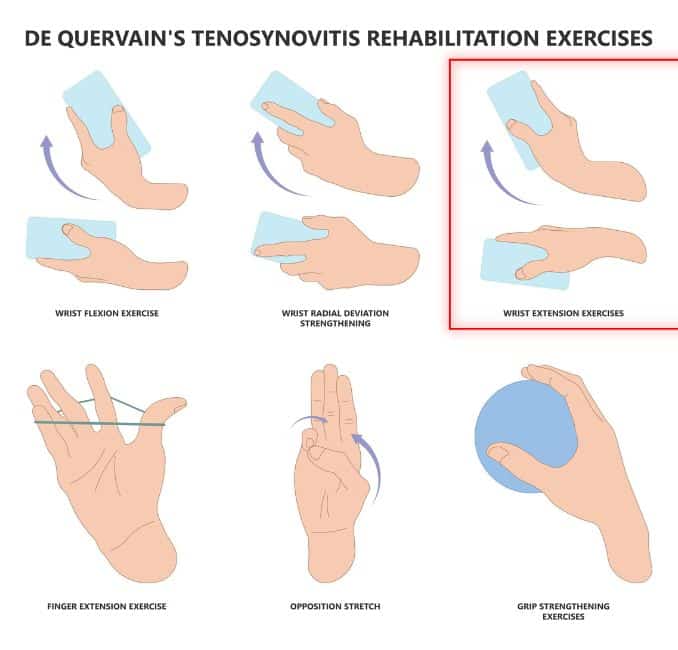
- For this De Quervain exercise, extend your arm with your palm facing down.
- Hold a small weight as you slowly bend your wrist up and back.
- You’ll feel a stretch at the back of your hand and wrist, relieving gamers thumb.
- Then, slowly bring your wrist back to its original position.
- Do 2 sets of 15. You can gradually increase the weight as you gain strength.
7. Wrist Radial Reviation Strengthening

- Extend your arm before you, palm facing inward while holding a weight.
- Your thumb should be on top.
- Then, balance your forearm on a table and your wrist positioned over the edge if you need extra support.
- Keeping your forearm still, gently bend your wrist with the thumb moving toward the ceiling.
- You’ll feel a stretch at the base of your thumb where it meets your wrist. Slowly lower your arm back down to the original position. After that, do 2 sets of 15.
8. Eccentric Radial Deviation Strengthening
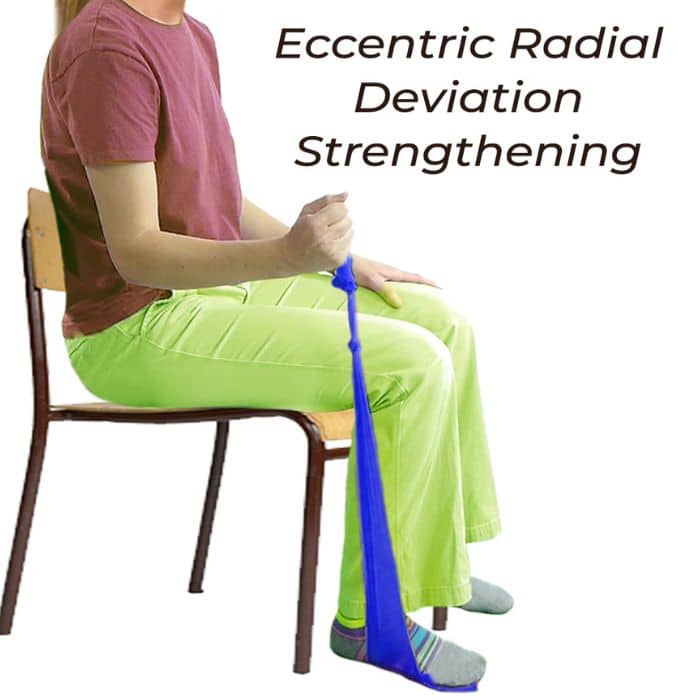
- Firstly, sit on a chair with your legs spread slightly open.
- Grasp one end of an elastic band with your right hand.
- Then, lean forward, put your right elbow on your right thigh, and let your forearm drop between your knees.
- Step on the other end of the elastic band using your left foot, making sure to keep your wrist in a neutral position to avoid triggering gamers thumb.
- With your palm facing down, slowly bend your right wrist to the side, away from your left knee.
- You’ll feel a stretch at the back and the inside of your hand. Repeat 8 to 12 times.
- Lastly, repeat this exercise on your left hand.
9. Grip Strengthening
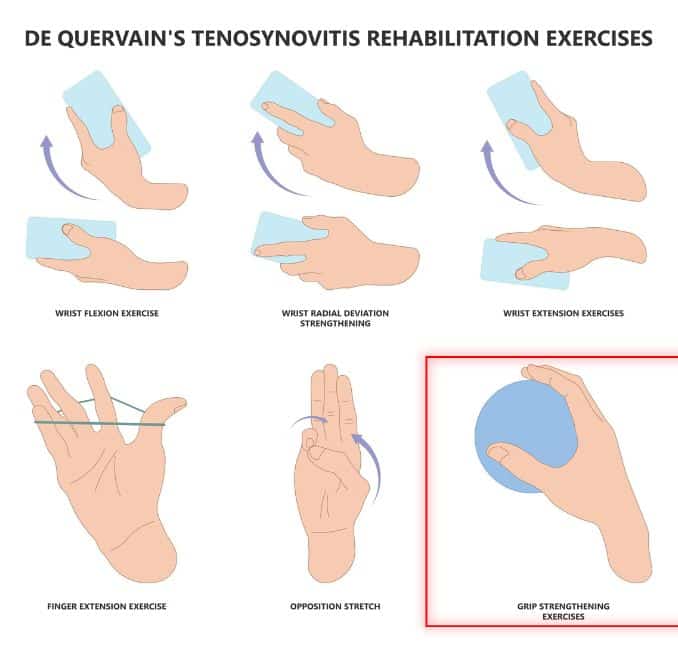
- Squeeze a putty ball for five seconds at a time. Do 2 sets of 15.
- Then, place a rubber band or hair tie around your thumb and fingers.
- Make sure the band is tight enough to offer some resistance, especially if you’re dealing with gamers thumb.
- Open your thumb to stretch the rubber band as far as you can.
- You’ll feel a stretch along your thumb. Do 2 sets of 15.
10. Finger Spring
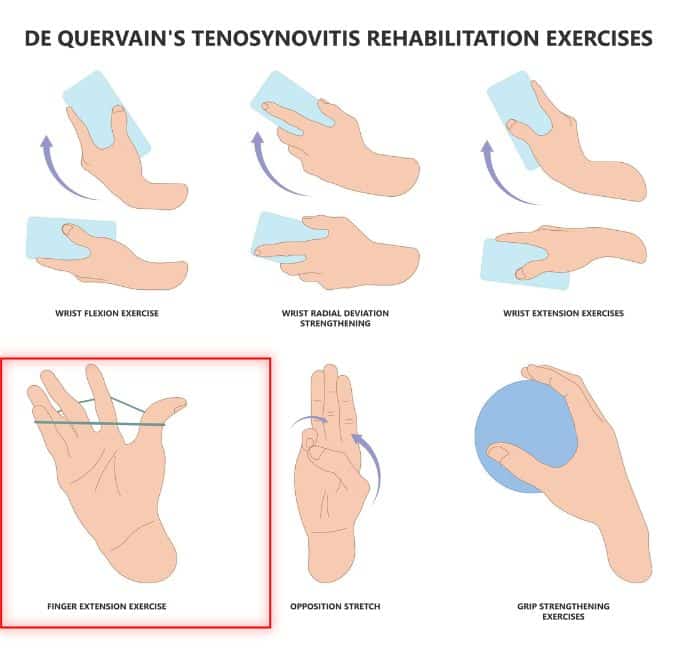
- Place a large rubber band around the outside of your thumb and fingers to help with gamers thumb.
- Then, open your fingers to stretch the rubber band. Do 2 sets of 15.
Conclusion
Dealing with gamers thumb and De Quervain’s tenosynovitis doesn’t have to be a lifelong struggle.
Whether through rest, therapy, or advanced treatments, relief is within reach.
My journey taught me the importance of acting early and seeking professional advice.
De Quervain’s tenosynovitis is a temporary condition.
It generally responds well to treatment.
So it is essential to treat de Quervain’s tenosynovitis.
If this condition isn’t treated, it can permanently limit your movement or cause the tendon sheath to burst.
Once your symptoms are better, work to prevent the condition from happening again.
You’ll likely make a full recovery with treatment.
If the activities that caused the condition aren’t stopped, problems may arise.
Therefore, the damage to your tendon may become permanent.
Over time, it can impact your mobility.
If you’re experiencing symptoms, don’t wait. Reach out to a healthcare provider and explore your options for De Quervain’s treatment. Your wrists will thank you!
Boost your strength safely and effectively! Try our Safe and Strong Seated Workout – Ankle and Wrist Weight Edition. Perfect for all fitness levels, this workout targets muscles without the strain, giving you a safe way to build strength and endurance. Grab your weights and let’s get moving!”
FAQs
1. What is The Patient Asked To Do During the Finkelstein Test?
- The patient will be asked to do a series of hand movements to test whether or not they are suffering from De Quervain’s Tenosynovitis.
- Specifically, the patient is asked to make a fist with their thumb tucked inside their fingers, then gently bend their wrist toward the pinky side.
- This movement places strain on the affected tendons, which may cause sharp pain if De Quervain’s Tenosynovitis is present.
2. How To Perform a Finkelstein Test?
- First, bend your thumb so it rests across your palm.
- Then, bend your wrist toward your little finger.
- Finally, you make a fist, closing your fingers over your thumb.
3. What is The Purpose of The Finkelstein Test?
- The main purpose of the Finkelstein Test is to diagnose De Quervain’s Tenosynovitis.
- By stretching the tendons along the thumb side of the wrist, the test helps healthcare providers determine if there is significant irritation or inflammation.
4. What Should You Expect to Feel During the Finkelstein Test?
- Without De Quervain’s: Most people without the condition feel a mild stretch without pain.
- With De Quervain’s: Individuals with the condition may feel sharp, intense pain along the side of the wrist, indicating inflammation or irritation.
5. Is the Finkelstein Test Painful?
- The test may be uncomfortable if inflammation is present.
- People with De Quervain’s often experience sharp pain, while those without it feel only a mild stretch.


